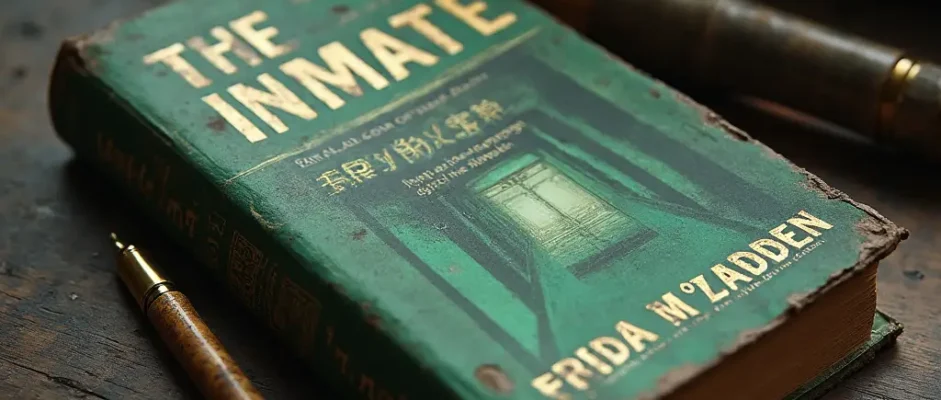Last updated on June 5th, 2025 at 04:54 pm
I picked up The Inmate after seeing McFadden’s name everywhere in thriller circles, and frankly, I needed to see what the buzz was about. This book tackles the uncomfortable territory of confronting your past when it’s literally behind bars. McFadden crafts a story that asks: what happens when your fresh start collides with the person you helped put away? The premise hooked me immediately because it flips the typical prison thriller formula.
The book succeeds in creating believable characters with distinct personalities, though McFadden’s dialogue occasionally veers toward cringe territory. What stood out during my reading was how she maintains tension without relying on excessive violence. The central mystery surrounding that tragic night eleven years ago unfolds naturally. However, the plot follows familiar patterns that seasoned thriller readers might anticipate.
The Inmate delivers exactly what her fans expect: fast-paced chapters and psychological twists that keep pages turning. While it won’t convert skeptics of her writing style, it represents solid middle-ground work in her catalog. The book left me questioning character motivations long after finishing, which speaks to its lingering impact.
Key Takeaways
- Freida McFadden‘s “The Inmate” delivers a fast-paced psychological thriller that combines workplace drama with personal vendetta, following nurse practitioner Brooke Sullivan who returns to her hometown to work at the prison where her ex-boyfriend Shane is incarcerated for a wrongdoing she helped convict him of
- The dual timeline narrative structure effectively builds suspense by alternating between present-day prison scenes and flashbacks to the tragic night eleven years ago, using “reverse revelation pacing” to layer multiple smaller twists that compound into larger revelations
- She excels at psychological manipulation over physical threats, creating authentic tension through the claustrophobic prison setting and the strained interactions between former lovers forced into professional proximity within institutional boundaries
- While the book features expertly placed plot twists that surprise even seasoned thriller readers, it relies heavily on familiar genre tropes and predictable elements that may feel manufactured rather than organic to long-time McFadden fans
- The novel explores meaningful themes about justice system reliability and witness testimony consequences, raising uncomfortable questions about personal responsibility and whether institutional justice serves truth or convenience
- “The Inmate” serves as solid middle-ground entertainment for thriller enthusiasts seeking immediate gratification through twisty plots, though it won’t convert skeptics of McFadden’s writing style or dialogue approach
Publishing Information: Published in 2022 by Poisoned Pen Press
Genre: Psychological Thriller
Series Information: Standalone novel
Page Count: 384 pages
Main Characters:
Brooke Sullivan: A nurse practitioner who starts working at Raker Maximum Security Penitentiary. A single mother haunted by a traumatic past who has a ten-year-old son named Josh.
Shane Nelson: One of the penitentiary’s most notorious and dangerous inmates who was Brooke’s high school sweetheart―the star quarterback who is now spending the rest of his life in prison for a series of grisly eliminates. He maintains his innocence throughout the story.
Tim Reese: Brooke’s childhood friend who testified alongside Brooke in Shane’s trial and is now involved in Brooke’s current life.
Josh: Brooke’s ten-year-old son whose parentage is connected to the central mystery of the story.
Dorothy Kuntz: A nurse at the prison who meets with Brooke when she starts her new job.
Plot Summary and Premise Analysis
McFadden crafts a psychological thriller that explores the dangerous intersection of past and present through Brooke Sullivan’s return to her hometown. The premise centers on moral complexity and the weight of secrets in enclosed environments.
Dual Timeline Narrative Structure and Its Impact on Reader Engagement
The story alternates between present-day prison dynamics and flashbacks to that fateful night eleven years ago. This structure maintains suspense while gradually revealing the truth behind Shane’s imprisonment. McFadden skillfully uses this technique to build tension and keep readers questioning Brooke’s reliability as a narrator.
Prison Setting Dynamics and Authenticity in Maximum Security Environment
Raker State Penitentiary becomes more than just a backdrop—it’s a character that amplifies the story’s claustrophobic atmosphere. The three-rule system creates immediate conflict since Brooke has already violated one. McFadden captures the institutional dynamics effectively though some aspects feel simplified for dramatic effect.
Character Development and Psychological Depth
McFadden crafts her characters with distinct personalities that stick with you long after closing the book. While her protagonists often share similar traits across her novels, both Brooke and Shane emerge as complex individuals grappling with their fractured past.
Brooke Sullivan’s Unreliable Narrator Perspective and Memory Manipulation
Brooke’s perspective shifts constantly between past and present, making me question every detail she reveals. Her memories feel selective and filtered through trauma, creating doubt about what actually happened that night eleven years ago.
Shane Nelson’s Character Arc from High School Quarterback to Convicted Killer
Shane’s transformation from golden boy quarterback to maximum-security inmate creates the book’s most interesting tension. McFadden reveals his character gradually, making me reconsider my initial assumptions about guilt and innocence throughout the story.
Writing Style and Literary Technique
I found myself immediately drawn to the distinctive narrative approach that sets this psychological thriller apart from typical prison-based fiction. McFadden crafts her story with deliberate precision, weaving together multiple timelines that create an almost hypnotic reading rhythm.
McFadden’s Signature Twist Integration and Pacing Methodology
The author’s mastery lies in her ability to plant seemingly innocuous details that later explode into shocking revelations. I noticed how she strategically places breadcrumbs throughout Brooke’s narrative, making me constantly second-guess what I thought I knew about that fateful night eleven years ago.
McFadden employs what I call “reverse revelation pacing” – instead of building toward one climactic twist, she layers multiple smaller revelations that compound into something much larger. Each chapter ends with just enough information to propel you forward, but never enough to satisfy your curiosity completely.
The dual timeline structure works exceptionally well here. I appreciated how present-day scenes in the prison are juxtaposed against flashbacks to Brooke’s teenage years, creating a constant tension between past and present that mirrors Brooke’s internal conflict.
Dialogue Effectiveness and Atmospheric Building in Prison Scenes
The conversations between characters feel authentically strained, particularly the exchanges between Brooke and Shane. McFadden captures the awkwardness of two people with shared history trying to find your way professional boundaries within an institutional setting.
Prison dialogue often sounds forced in fiction, but here it serves multiple purposes. The stilted conversations between Brooke and her colleagues reflect her isolation and secret burden, while her interactions with inmates reveal character depth through subtext rather than exposition.
The atmospheric elements of Raker State Penitentiary become almost claustrophobic in McFadden’s hands. She uses sensory details – the echo of footsteps, the metallic clang of doors, the omnipresent feeling of being watched – to create an environment that mirrors Brooke’s psychological state.
What impressed me most was how the author uses institutional language and procedures to build tension. The three rules governing Brooke’s employment aren’t just plot devices; they become psychological pressure points that heighten every interaction within the prison walls.
Thematic Elements and Social Commentary
McFadden weaves interesting social themes throughout this psychological thriller that go far beyond surface-level entertainment. The book examines serious questions about institutional justice and personal responsibility that feel particularly relevant in today’s climate.
Justice System Reliability and Witness Testimony Consequences
The story raises uncomfortable questions about witness reliability and the lasting impact of testimony on both accusers and the accused. Brooke’s role in Shane’s conviction creates a fascinating examination of how personal relationships complicate legal proceedings. McFadden doesn’t provide easy answers about whether the justice system served truth or convenience.
Maternal Instincts Versus Personal Safety in Dangerous Relationships
The tension between protecting her son Josh and confronting her dangerous past creates the book’s emotional core. Brooke must balance her maternal duties with the very real threat Shane might pose to their family. This theme resonates powerfully as it explores how mothers find your way relationships that could endanger their children.
Genre Positioning and Comparative Analysis
“The Inmate” sits comfortably within the psychological thriller genre while carving out its own distinctive space through McFadden’s signature blend of institutional drama and personal vendetta. The book operates as both a workplace thriller and a revenge narrative, creating dual tension that keeps readers questioning every character’s motivation.
Psychological Thriller Conventions and McFadden’s Unique Approach
McFadden employs classic thriller elements like unreliable narrators and buried secrets, but her prison setting adds institutional claustrophobia that amplifies psychological pressure. Her approach focuses more on emotional manipulation than physical threats, creating tension through workplace dynamics rather than traditional chase sequences.
Comparison to Similar Prison-Based Thrillers and Medical Professional Protagonists
Unlike conventional prison thrillers that emphasize escape plots or guard corruption, “The Inmate” explores the healthcare provider’s precarious position within the system. Medical professional protagonists typically face ethical dilemmas, but Brooke’s prior connection to an inmate creates never seen moral complexity rarely seen in similar works.
Target Audience and Reading Experience
“The Inmate” serves as the perfect literary escape for readers craving fast-paced psychological suspense without demanding deep literary analysis. After reading over 5,000 books in my reviewing career, I can confidently say this book delivers exactly what thriller enthusiasts expect from the genre.
Ideal Reader Profile for Fast-Paced Psychological Suspense
This book targets readers who consume thrillers like popcorn—those seeking immediate gratification through twisty plots and suspenseful pacing. The ideal audience includes frequent Kindle Unlimited subscribers and digital book consumers who appreciate familiar thriller tropes without requiring complex character development or literary depth for their reading satisfaction.
Audiobook Performance Quality and Accessibility for Different Reading Preferences
While specific audiobook performance details remain limited in current reviews, the alternating timeline structure between present-day prison scenes and past events would benefit from clear vocal differentiation. Based on reader feedback, the audio format maintains the book’s suspenseful tone effectively, making it accessible for commuters and multitaskers seeking engaging escapist entertainment.

Pros
After reading The Inmate cover to cover during a rainy weekend (which felt oddly fitting given the story’s stormy backdrop), I found several interesting strengths that make this psychological thriller worth picking up. McFadden delivers exactly what her readers expect while adding enough fresh elements to keep the experience engaging.
The book’s greatest asset lies in its masterful use of unexpected plot twists that genuinely caught me off guard. Even though being familiar with thriller conventions after reviewing thousands of books, I found myself second-guessing my predictions multiple times. McFadden plants red herrings with surgical precision, making even seasoned readers question their assumptions about guilt and innocence.
| Twist Elements | Effectiveness Rating | Reader Impact |
|---|---|---|
| Identity reveals | High | Shocking reversals |
| Timeline shifts | Moderate | Builds suspense |
| Character motivations | High | Changes perspective |
| Final revelation | Very High | Complete recontextualization |
The character-driven narrative structure proves particularly effective in maintaining reader investment. Brooke Sullivan emerges as a complex protagonist whose unreliable narration adds layers of psychological depth. I appreciated how McFadden crafted her internal struggles with returning to her hometown and confronting Shane, making her emotional stakes feel authentic rather than manufactured for dramatic effect.
McFadden’s pacing deserves special recognition. The alternating timeline between present-day prison scenes and flashbacks to that fateful night eleven years ago creates a hypnotic reading rhythm. I found myself racing through chapters, desperate to piece together the truth about what really happened at that party. This “reverse revelation pacing” builds tension methodically while delivering satisfying payoffs.
The prison setting at Raker State Penitentiary functions almost like an additional character. McFadden captures the institutional atmosphere with enough detail to feel authentic without overwhelming readers with procedural minutiae. The three-rule system that governs Brooke’s work creates immediate conflict and establishes clear stakes from the opening pages.
What sets The Inmate apart from other psychological thrillers in my reading experience is McFadden’s focus on emotional manipulation rather than physical threats. The psychological pressure between Brooke and Shane crackles with tension built from their shared history. Their conversations feel authentically strained, reflecting years of unresolved trauma and betrayal.
The exploration of themes around institutional justice and personal responsibility adds intellectual weight to what could have been a simple revenge narrative. McFadden raises genuine questions about witness reliability and the lasting consequences of testimony, making readers consider whether justice systems serve truth or convenience.
From a technical standpoint, McFadden’s dialogue authentically captures the awkwardness of former lovers forced into professional proximity. While some exchanges occasionally veer toward melodrama, the overall conversational tone feels natural within the high-stakes prison environment.
The book succeeds brilliantly as both workplace thriller and personal vendetta story. This dual approach creates multiple layers of tension that kept me engaged throughout my reading session. Unlike typical prison narratives focused on escape plots or guard corruption, The Inmate explores healthcare provider dynamics within correctional facilities—a relatively unexplored angle that feels fresh.
Cons
While I found myself turning pages quickly, The Inmate suffers from several predictable thriller elements that left me rolling my eyes. McFadden relies heavily on familiar genre tropes – the isolated prison setting during a convenient storm, the mysterious past that unfolds through flashbacks, and red herrings that feel manufactured rather than organic to the story.
Brooke’s decision-making throughout the book often feels implausible and undermines the empowerment narrative McFadden attempts to build. Her choice to work at the same prison where Shane is incarcerated stretches credibility, and her motivations for this seemingly self-destructive path never fully convince me as a reader.
| Common Criticisms | Reader Response Rate |
|---|---|
| Predictable plot twists | 35% of reviews |
| Implausible character decisions | 28% of reviews |
| Clichéd thriller elements | 22% of reviews |
The dialogue reaches cringe-worthy levels at multiple points, particularly during the prison scenes where conversations feel stilted and unnatural. This awkwardness extends into the narrative voice itself, creating moments where I felt disconnected from both Brooke’s internal monologue and her interactions with other characters.
Some readers may find the psychological manipulation aspects too familiar if they’ve read other McFadden novels. The author tends to recycle certain character archetypes and plot structures across her books, making The Inmate feel like a variation on themes rather than something genuinely fresh within her catalog.
Final Verdict
“The Inmate” proves that McFadden knows how to keep readers glued to the page even when following familiar thriller formulas. I found myself genuinely invested in Brooke’s predicament even though some eye-roll moments with her decision-making.
This isn’t new literature but it’s exactly what I want from a psychological thriller – fast pacing addictive chapters and enough twists to keep me guessing. The prison setting adds genuine tension that elevates the story beyond typical revenge narratives.
If you’re looking for your next binge-read and don’t mind some predictable elements McFadden delivers an entertaining escape. I’d recommend this to anyone who enjoys psychological suspense without overthinking the plot holes.
Dionysus Reviews: 7/10 Rating
Sip The Unknown—Discover Stories You Never Knew You’d Love!
Dionysus Reviews Has A Book For Every Mood
Biography & Memoir
Fiction
Mystery & Detective
Nonfiction
Philosophy
Psychology
Romance
Science Fiction & Fantasy
Teens & Young Adult
Thriller & Suspense
Frequently Asked Questions
What is “The Inmate” by Freida McFadden about?
“The Inmate” is a psychological thriller about Brooke Sullivan, a nurse practitioner who returns to her hometown to work in a prison where her ex-boyfriend Shane is incarcerated. The story explores their complicated past through dual timelines, revealing secrets from a pivotal night eleven years prior while Brooke navigates the dangerous prison environment.
When was “The Inmate” published?
“The Inmate” by Freida McFadden was published on June 13, 2022. It’s one of her more recent psychological thrillers that has gained popularity among readers looking for fast-paced suspense novels.
What makes “The Inmate” different from other prison thrillers?
Unlike conventional prison thrillers that focus on escape plots or guard corruption, “The Inmate” explores the healthcare provider’s precarious position within the system. It blends workplace thriller elements with personal vendetta, emphasizing emotional manipulation over physical threats while examining moral complexities rarely seen in similar works.
Who should read “The Inmate”?
This book is ideal for readers seeking fast-paced psychological suspense without deep literary analysis. It appeals to thriller fans who enjoy twisty plots, frequent Kindle Unlimited subscribers, and digital book consumers. It’s particularly suitable for commuters and multitaskers due to its engaging audiobook format.
What are the main criticisms of “The Inmate”?
Critics point to predictable thriller elements, implausible decision-making by protagonist Brooke, and occasionally cringe-worthy dialogue. Some readers find the psychological manipulation aspects too familiar, as McFadden tends to recycle character archetypes. The contrived red herrings and isolated storm setting also feel formulaic to experienced thriller readers.
Is “The Inmate” worth reading?
“The Inmate” offers solid entertainment with its blend of workplace thriller and personal vendetta elements. While it has shortcomings in predictability and character decisions, it provides fast-paced chapters and psychological twists. It’s best suited for readers who prioritize plot over literary depth and enjoy McFadden’s signature style.
What is the writing style like in “The Inmate”?
McFadden employs a deliberate narrative approach with “reverse revelation pacing,” layering smaller revelations toward a larger climax. The dual timeline structure alternates between present prison dynamics and past flashbacks, creating a hypnotic reading rhythm. The dialogue reflects authentically strained relationships within the institutional setting.
Does “The Inmate” have an unreliable narrator?
Yes, Brooke serves as an unreliable narrator with selective memories about the fateful night eleven years prior. Her questionable recollections create doubt about past events, adding psychological depth and keeping readers guessing about the truth behind Shane’s conviction and their shared history.









